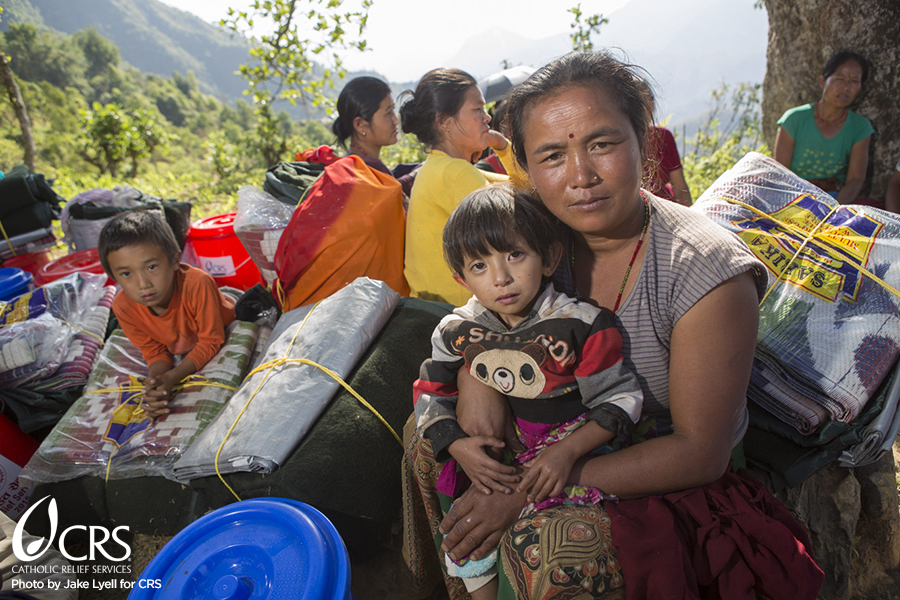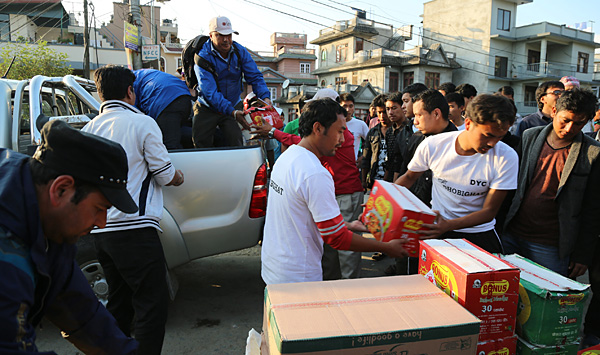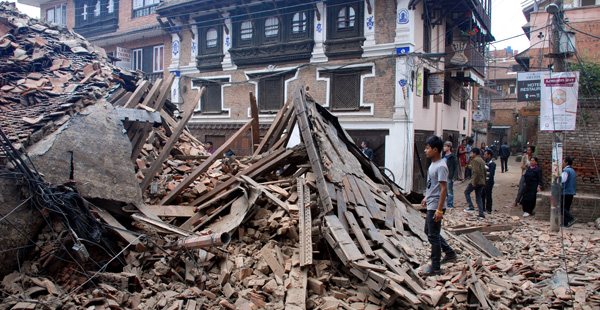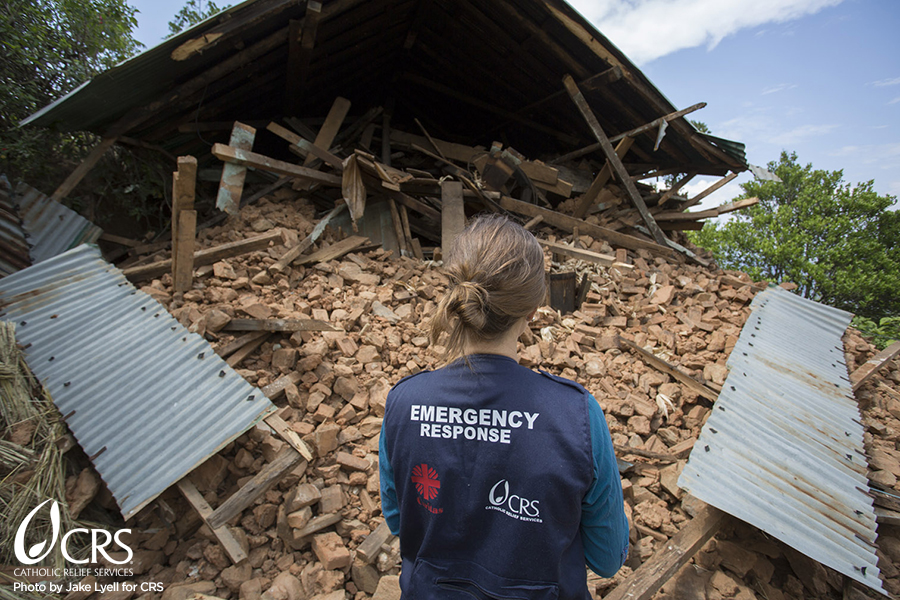

Media CenterNepal Earthquake: On the 3-Month Anniversary, Watch How Your Donations Made a Difference
Updated July 25, 2015
Today marks the 3-month anniversary of the devastating 7.8 magnitude Nepal earthquake -- the first of two major earthquakes that caused loss of life, homes and income. But thanks to your generosity, you brought emergency aid to those in need. Watch how your donations provided families with critical items, such as tarps, blankets and shelter. ——————————————————————————————
Updated June 8, 2015

With monsoon season quickly approaching, Catholic Relief Services (CRS) is working with Caritas Nepal to get relief supplies to thousands of those whose lives and livelihoods were shaken by the April 25 earthquake and aftershocks before roads become nearly impassable.
“During monsoon season, moving construction materials and relief goods will be very difficult or impossible,” said Jen Hardy, CRS Regional Information Officer for Asia.
“That’s why we are working so fast to give families the materials they need right away – we know they need to make their emergency shelters as strong as possible, as quickly as possible, to make the rains more bearable.”
Some 575 households in hard hit communities, mainly in the Gorkha district west of Kathmandhu, have already received items to construct transitional shelters – the first step toward permanent rebuilding -- such as corrugated galvanized iron (CGI) sheeting, tool kits, nail kits and sleeping materials. Water, sanitation and hygiene (WASH) kits have gone to 1,282 households. The WASH supplies include rehydration salts, water storage containers, sanitary cloths, bathing and laundry materials and dental supplies, enough to last three months, until the end of monsoon season.
CRS plans to provide kits to an additional 560 households over the next couple of days. On April 25th, the 7.8 magnitude earthquake struck Nepal, killing at least 8,669 people and destroying an estimated 500,717 houses, with several hundred thousand more damaged. Two weeks later, on May 12th, a 7.3 magnitude aftershock exacerbated these conditions and made it significantly difficult to reach certain areas of the country. However, CRS plans to dispatch trekking teams and logistics staff to the Northern Gorkha District, which is currently cut off, to survey the region and make arrangements for the distribution of shelter materials.
In the Central Gorkha District, CRS and Caritas will give cash grants to vendors to repair and construct infrastructure. In addition, CRS and Caritas have collaborated with Mega Bank Nepal Ltd. to donate cash to some 1,300 households in Southern Gorkha.
Over the course of the coming weeks, CRS intends to provide assistance to over 6,000 households in the Northern, Central and Southern Gorkha Districts. Currently, an assessment is being made to determine the amount of labor needed to clear debris and rebuild.
CRS has committed $10 million to a 3 year program for relief in Nepal. The target reach of this proposal is 15,000 families, an estimated 75,000 people total. The immediate priority is in providing emergency relief; however, CRS intends to remain committed to the people of Nepal for years to come, as they undergo a process of rebuilding.
——————————————————————————————
Updated May 22, 2015 at 9:30 am
Two powerful earthquakes recently struck Nepal on April 25th and May 12th, bringing two waves of devastating damage. When the second earthquake hit, Catholic Relief Services (CRS) teams were out in the field in the Gorkha district, reaching people in communities damaged in the first quake with relief supplies.
“A school right at our distribution site partially collapsed,” said Jennifer Hardy, CRS Regional Information Officer who was on the scene. “But no one was hurt there and within ten minutes we were back at work, handing out emergency shelter and sanitation supplies.”
The latest earthquake, centered about 50 miles east of Nepal’s capital Kathmandu, was magnitude 7.3. The April 25 quake registered 7.8. It killed at least 8,000 people. Casualty reports from the latest temblor were just filtering in.
Hardy reported that all CRS staff are safe. CRS, which has committed $10 million to Nepal’s relief and recovery, has tried to reach people in outlying areas, a challenge as already bad roads were damaged in the earthquake.
CRS and Caritas Nepal teams had worked especially hard to reach today’s distribution in the village of Satdobato in the Gorkha district, about 50 miles west of Kathmandu, near the epicenter of the April 25 quake. Overnight rains made bad roads almost impassable and supplies had to be transferred from one vehicle to another to reach the distribution site. People walked for hours from their even more remote villages to get the supplies, badly needed as many lost their homes in the April 25 quake and these rains portend the coming monsoon season.
Hardy said Sadobato is on a ridge so the shaking seemed especially intense as people realized this was not just another aftershock.
“I was in a grove of mango trees where a lot of people had gathered,” she said. “I watched two houses collapse as I held this little grandmother who was crying. Mango tree leaves fell all around us like snow it shook so hard.”
------------------------------------------------------------------------------------------

Updated May 4, 2015 at 11:00 am
Catholic Relief Services (CRS) teams are distributing emergency relief supplies to hundreds of people in Nepal’s Gorkha district, a remote mountainous area heavily affected by a 7.8 earthquake that struck the country on April 25.
To date, 2,500 people living here have received emergency shelter kits, including tarps and tools, as well as other critical items like blankets and sanitation items. The items provided much needed relief as most homes in Gorkha district have either collapsed completely or suffered significant damage.
“Even people whose homes just have cracks are sleeping outside for fear of aftershocks,” Jennifer Hardy, CRS’ Regional Information Officer said from Gorkha. “You can see on people’s faces that they’re stressed and exhausted, and don’t know how to move forward. Many worry about not being able to afford to rebuild their houses.”
With frequent rains and cold temperatures at night, thousands are sleeping on the cold, wet ground. Logistics to get critically needed items to these very remote areas are difficult.
“To get to our distribution site, we had to drive two hours over a rugged dirt road, and families had to walk three hours to meet us there,” Hardy said about the items that had already been trucked into Nepal form neighboring India as there are few supplies available locally. “Villages are very spread out and some are only accessible by footpath. The dirt roads are so bad we had to hire tractors to get up the roads.”
The CRS supplies – including tarpaulins and tools needed to construct temporary shelters as well as sanitation and hygiene items – were pre-positioned in Bihar, a state in India that borders Nepal, as the area was known to be earthquake-prone. Trucking them to Kathmandu was a challenge due to damage to roads. More supplies coming from Dubai – delayed by Kathmandu’s overcrowded airport -- will arrive as soon as possible and distributed immediately.
Families in Gorkha district mostly earn a living through farming, and many continue to work in their corn fields.
“Luckily, farming activities have not been affected as much as housing and I’ve seen people hoe their fields, where the corn is about a foot tall right now,” Hardy said. “But with the corn harvest several weeks away and people’s food reserves buried under rubble, many are worried about their incomes in the near future.”
CRS is working with Caritas Nepal and a number of other Caritas agencies from around the world, including India, Australia and the United Kingdom, all responding to the 7.8 magnitude earthquake that has left over 7,000 dead, a number that could still rise as relief workers reach more areas of this mountainous country.
CRS, which has committed a minimum of $10 million to Nepal, plans to reach 15,000 families – 75,000 people – with emergency relief in the next few weeks and continue for years in assisting in rebuilding.
“The recovery will be difficult.” Hardy said. “People are so spread out over such steep terrain, even after we reach them with immediate, emergency relief, it will also be difficult to reach them with goods for their recovery. We are coordinating with our partner Caritas Nepal to make sure we are set up well to meet recovery needs.”
------------------------------------------------------------------------------------------
Updated May 1, 2015 at 12:00 pm
Emergency relief supplies brought into Kathmandu by Catholic Relief Services (CRS) are being assembled for distribution to those suffering in the wake of the powerful earthquake that struck Nepal Saturday.
CRS will truck the supplies – designed to help those living outside due to earthquake damage and fears – over damaged roads to a distribution location 30 miles from Nepal’s capital city to begin to reach people in outlying areas.
“We have all seen images of the damage in Kathmandu,” said Jennifer Hardy, CRS Regional Information Officer who is in Nepal. “But we know that there is more unseen devastation in areas further away, many of them inaccessible to this point. Getting these items into the hands of the people of Nepal is the beginning of what will be a long and difficult task of recovery and rebuilding.”
Thousands of homes were destroyed by the earthquake leaving their residents with no shelter. Many others are choosing to live outside as severe aftershocks have continued. Cold weather, rain and wind have made conditions miserable.
The CRS supplies – including tarpaulins and tools needed to construct temporary shelters as well as sanitation and hygiene items – were pre-positioned in Bihar, a state in India that borders Nepal, as the area was known to be earthquake-prone. Trucking them to Kathmandu was a challenge due to damage to roads. More supplies coming from Dubai are expected to arrive in Kathmandu as soon as possible, based on the capacity of the city’s only airport, and will be distributed immediately.
CRS is working with Caritas Nepal and a number of other Caritas agencies from around the world, including India, Australia and the United Kingdom, all responding to the 7.8 magnitude earthquake that has left over 6,000 dead, a number that is expected to rise as relief workers reach more areas of this mountainous country.
CRS, which has committed a minimum of $10 million to Nepal, plans to reach 15,000 families – 75,000 people – with emergency relief in the next few weeks and continue for years in assisting in rebuilding.
----------------------------------------------------------------

Updated April 28, 2015 at 3:00 pm
Reports from Catholic Relief Services (CRS) emergency personnel in Kathmandu tell of cold rain making life miserable for the tens of thousands who have been living outside in fear of continuing aftershocks since the 7.8 magnitude earthquake that struck Nepal Saturday.
“The situation is getting critical with the rain and cold winds,” said Kushal Neogy, a member of the CRS India staff who was in Nepal during the earthquake and has stayed to help with relief efforts.
“It slows down the rescue and relief operation and makes life difficult for those living on the street or in open fields.”
CRS will bring help to many of those people soon as thousands of tarpaulins and other shelter materials are on their way overland from neighboring India where they were pre-positioned because the area is subject to earthquakes and severe flooding. Thousands more tarpaulins are being flown from a distribution center in Dubai.
Neogy and about 20 more CRS emergency specialists are now in Nepal or on the way. They are working with Caritas Nepal, alongside staff from Caritas agencies around the world, including the United Kingdom, India, Australia, Germany, Austria, and others.
CRS has an immediate goal of helping 10,000 families with emergency shelter, blankets, water treatment kits, and hygiene kits. CRS will help many more people as it assesses the needs and coordinates with other aid agencies.
“The main challenge at this point is overstress of a small airport,” said Elizabeth Tromans of CRS’ Humanitarian Response Team “With only one airport serving the area and it being a very small airport, we’re already seeing a backlog. For example, our first relief supplies were supposed to land this morning and were diverted, so we are hoping they come tomorrow.”
Caritas Nepal has been able to help some people, many who have taken refuge at a Catholic Church.
“We are not feeling safe inside the house, but feeling more safe outside, under this tent in the Assumption Church and it is near our house,” one them, Renuka Magdalene Thakuri, told Caritas Australia. “We feel save in the church premise and thankful to Caritas Nepal for the tent.”
“We hope to go back to our house soon, but are hesitating because of the aftershocks,” the 54-year-old said. “We have been here for two days, we have food and water, but shops and markets are closed. We are managing somehow though.”
Generous CRS donors have pledged more than a half million dollars to help victims of this disaster which struck one of the poorest countries in the world. The official death toll is now over 5,000 and that is expected to rise significantly as relief workers reach rural villages now cut off by landslides.
A prayer for Nepal is available in the CRS Resource Center.
--------------------------------------------------------------------
Posted April 27, 2015 at 11:52 am

Catholic Relief Services (CRS) emergency personnel have landed in Kathmandu to begin helping tens of thousands of people affected by the powerful earthquake that struck Nepal Saturday.
Twenty CRS emergency specialists are on the way to Kathmandu, Nepal’s capital, where many buildings collapsed in the 7.8 magnitude earthquake centered about 50 miles northwest of the capital city.
The initial targets of CRS aid will be the thousands in need of shelter, not only because many buildings were destroyed or damaged in the 7.8 magnitude earthquake, but also because continuing aftershocks are causing widespread fear of sleeping inside of even intact buildings.
“Rainfall last night made life difficult for those forced to remain outside,” said CRS India staffer Kushal Neogy who was in Nepal during the earthquake.
“Thankfully the rain stopped around 11 p.m. and people were able to sleep peacefully through the night as there were no major tremors. The morning started with a bright sunny day, but occasional rain is predicted today and tonight with strong winds as well,” he added.
Working with Caritas Nepal, CRS’s initial goal is to help 10,000 families with emergency shelter, blankets, water treatment kits, and hygiene kits. Given the scale of the disaster, the number receiving help is expected to rise as our staff and partners are able to better assess the situation, coordinate our response with other agencies and procure additional supplies.
As this region, especially northern India, is vulnerable to natural disasters like severe flooding and even earthquakes, CRS had prepositioned stocks of emergency aid in Bihar, India. These supplies -- temporary shelter kits (tarpaulins, mats, rope), water purification kits and hygiene kits for 2,000 families – are being transported to Nepal for immediate distribution.
Teams are also purchasing and transporting other critical relief items from India to transport into Nepal since most markets in Kathmandu remain closed. An additional 3,000 tarpaulins will be flown from a hub in Dubai for distribution within the next couple days. More emergency personnel are on the way.
CRS has made an initial commitment of $825,000 to relief efforts in Nepal, a figure that is expected to rise as the needs become clearer. The official death toll is approaching 4,000 – with thousands more injured -- but few outlying villages have been reached and widespread destruction, especially in hillside settlements, is feared.


